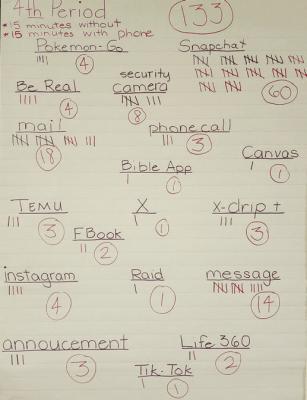Teacher’s cellphone experiment brings eye-opening results
In today’s digital age, cell phones have become an integral part of our lives. While they offer numerous benefits, they can also be a significant distraction, especially in educational settings. As educators, it is crucial to create an environment that promotes focused learning and engagement.
During a recent lesson in my class, I allotted 30 minutes for students to use their cell phones freely during class. The results were eye-opening. The constant stream of notifications disrupted the flow of the class, diverting attention away from the lesson at hand. Each notification symbolized a potential loss of valuable instructional time and hindered the learning experience for everyone involved. There were over 1,300 notifications in four classes with one class receiving 876 notifications in the 30 minutes. Most notifications came from social media sources like Snapchat and Instagram.
To address this issue, it is essential to establish clear guidelines regarding cell phone usage during class time. Encouraging students to put away their devices can significantly enhance their ability to concentrate and actively participate in classroom activities.
Here are some compelling reasons why implementing a “put away your phone” policy can benefit both students and educators: 1. Enhanced Focus: By removing distractions caused by cell phones, students can better direct their attention towards the subject matter being taught. This allows for deeper understanding and improved academic performance.
2. Improved Classroom Dynamics: With undivided attention from all students, classroom discussions become more engaging and interactive. The exchange of ideas becomes seamless, fostering a collaborative learning environment.
3. Reduced Anxiety: Students often feel pressured to constantly check their phones for fear of missing out on important updates or social interactions. By eliminating this pressure during class time, we create a calmer atmosphere that promotes mental well-being.
4. Respect for Education: Encouraging students to put away their devices sends a powerful message about the value we place on education as well as respect for teachers and peers.
Regular communication between teachers, students, and parents is critical in effectively managing cell phone use in the classroom. Teachers should regularly remind students about the rules and explain why they are in place. Seeking feedback from students allows educators to adapt policies based on their impact on student learning.
Educational institutions also have a responsibility to educate students about responsible cell phone use. Discussions on topics such as excessive screen time and digital citizenship can help students develop healthy habits and make informed decisions.
Moreover, educators must lead by example when it comes to using cell phones responsibly. By modeling appropriate behavior in the classroom, teachers show students how to effectively incorporate technology into their learning experience.
In addition to utilizing technological tools, educators need to establish clear guidelines and expectations regarding cell phone use. By specifying when and how devices can be used in the classroom, teachers help students understand the boundaries and responsibilities associated with cell phone use. Fort Stockton ISD has implemented the following cell phone policy: The policy permits students to possess personal cell phones for safety purposes; however, these devices, and any accessories, must be on silent/off and must remain at all times in the student’s pocket, backpack, laptop case, or purse except before school, during the lunch break, and after school. In order to maintain the privilege of the use of electronics on campus, students must meet the following criteria:
• Maintain a passing grade in all assigned classes on progress report or report card, and
• Maintain a 95% attendance rate, as reviewed at the end of each progress report or report card, and
• Pass all required STAAR assessments in the previous school year, and
• Refrain from all forms of cyberbullying during or after school, and
• Refrain from any form of property damage, for example, Tik-Tok challenges, and
• Refrain from using electronic device to record and/or share inappropriate content, recordings of staff or students, acts of violence, and/or fights.
Note: The privilege of electronic device usage may be revoked for behavior issues as determined by the Campus Leadership Team. By implementing policies that regulate cell phone use, along with providing guidance, resources, and education, educational institutions can create an environment that maximizes student engagement and learning outcomes while minimizing distractions.



